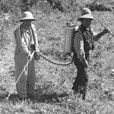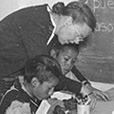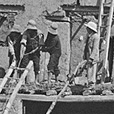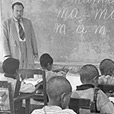Cornell - Peru Project
The Impact of the Vicos Experiment

 The fate of the introduced potato seed along with fertilizers and pesticides in Vicos, has been echoed in various parts of the world where technology has been the primary hope for improving people's lives. Initial success ended in ultimate failure accompanied by the loss of diversity.3 Demonstrations were carried out on the plots formerly allocated to the patrones, now in the hands of the project staff and half of the profits were saved for communal projects. In the first year, potato production doubled and by 1954 Vicos became the second largest potato producer in the Callejón de Huaylas. The income generated allowed Vicosinos to build a new school, engage in local public works and save for a down payment to buy the land. By 1967-68 Vicos sold 182.9 metric tons of potatoes, about two-percent of the reported yearly total, to the Lima wholesale market (Doughty 2004). But in a few years, production fell through the floor when new diseases attacked the introduced varieties.
The fate of the introduced potato seed along with fertilizers and pesticides in Vicos, has been echoed in various parts of the world where technology has been the primary hope for improving people's lives. Initial success ended in ultimate failure accompanied by the loss of diversity.3 Demonstrations were carried out on the plots formerly allocated to the patrones, now in the hands of the project staff and half of the profits were saved for communal projects. In the first year, potato production doubled and by 1954 Vicos became the second largest potato producer in the Callejón de Huaylas. The income generated allowed Vicosinos to build a new school, engage in local public works and save for a down payment to buy the land. By 1967-68 Vicos sold 182.9 metric tons of potatoes, about two-percent of the reported yearly total, to the Lima wholesale market (Doughty 2004). But in a few years, production fell through the floor when new diseases attacked the introduced varieties.
 Attempts to introduce cattle and milk production by the Ministry of Agriculture failed because the animals could not survive in the inhospitable
environment of the high pastures. The extension workers responsible for the project were expelled in 1973-74, but only after devastating economic loss
to the community and a decline of confidence in government projects. Cornell's economic programs of the 50's and 60's focused on male heads of
households who were politically connected, excluding women and the very poor. Therefore, the benefits of the programs were not shared by all members of
the community. The gap between the relatively well off and the poor widened, a lesson learned globally through the so-called Green Revolution. By 1970
commercial potato production could not be sustained due to nematode infestations and the decline of soil fertility. Cornell researchers left and the
'Miracle in Vicos' unraveled. Technological innovations alone do not promote equality but rather widen economic disparities.
Attempts to introduce cattle and milk production by the Ministry of Agriculture failed because the animals could not survive in the inhospitable
environment of the high pastures. The extension workers responsible for the project were expelled in 1973-74, but only after devastating economic loss
to the community and a decline of confidence in government projects. Cornell's economic programs of the 50's and 60's focused on male heads of
households who were politically connected, excluding women and the very poor. Therefore, the benefits of the programs were not shared by all members of
the community. The gap between the relatively well off and the poor widened, a lesson learned globally through the so-called Green Revolution. By 1970
commercial potato production could not be sustained due to nematode infestations and the decline of soil fertility. Cornell researchers left and the
'Miracle in Vicos' unraveled. Technological innovations alone do not promote equality but rather widen economic disparities.


The Cornell team set out to improve health and education. They built a school to accommodate 250 students using communal labor, replacing the old
school, which fewer than 30 boys attended. They also established a school lunch program that vastly improved the children's nutrition.


Instilling democracy and self-determination was another of the primary objectives of the Cornell Peru Project. A governance structure representing the
10 barrios, or sectors of the hacienda of Vicos, was set up with an elected village council. That structure exists today.

